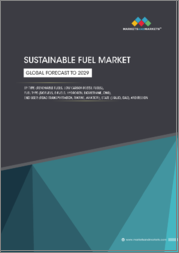
|
시장보고서
상품코드
1518462
에탄올 e-fuel(합성연료) 시장 : 재생에너지별, 기술별, 용도별, 성장, 예측(2024-2032년)Ethanol E-Fuel Market - By Renewable Energy (On-Site Solar, Wind), By Technology (Fisher-Tropsch, eRWGS), By Application (Automotive, Marine, Aviation, Industrial), Growth Forecast, 2024 - 2032 |
||||||
에탄올 e-fuel(합성연료) 시장 규모는 GHG 배출 삭감에 대한 세계의 의식의 향상과 규제 압력에 의해 촉진되며, 2024-2032년에 CAGR 34% 이상을 기록합니다.
더 깨끗하고 재생한 에너지원인 에탄올 e-fuel(합성연료)는 화석연료를 대체할 수 있는 대안이 될 수 있으며, Our World in Data에 따르면 2023년 전 세계 화석연료 소비량은 석유, 석탄, 가스가 각각 54,500 TWh, 45, 500, 40,100 TWh를 초과할 것으로 예상됩니다. 500 TWh, 40,100 TWh를 초과할 것으로 예상됩니다. 자동차 산업이 하이브리드 및 유연 연료 차량으로 전환하고 있는 것은 에탄올 e-fuel(합성연료)에 대한 수요를 증가시키고 있습니다. 또한 기존 엔진에 큰 변화를 주지 않고 기존 연료와 혼합할 수 있는 에탄올 e-fuel(합성연료)의 가능성은 소비자와 제조업체 모두에게 매력적인 선택지가 되어 시장 성장을 더욱 촉진하고 있습니다.
에탄올 e-fuel(합성연료) 산업은 재생에너지, 기술, 용도, 지역별로 분류할 수 있습니다.
풍력발전으로 생산된 전력이 에탄올 생산에 활용되므로 풍력에너지 분야의 점유율은 2032년까지 빠르게 확대될 것입니다. 풍력발전소는 풍황이 좋은 지역에 설치되어 에탄올 생산에 따른 이산화탄소 배출량 감소에 크게 기여합니다. 풍력에너지의 확장성과 환경적 이점으로 인해 풍력에너지는 탄소 배출을 최소화하고 에너지의 지속가능성을 높이고자 하는 에탄올 생산업체들에게 바람직한 선택이 될 수 있습니다. 풍력에너지 인프라에 대한 투자는 전 세계에서 계속 확대되고 있으며, 앞으로 더 많은 성장이 예상됩니다.
산업계는 규제 요건과 기업의 지속가능성 목표를 충족하기 위해 기존 화석 연료를 대체할 수 있는 지속가능하고 친환경적인 대체 연료를 찾는 경향이 증가하고 있으며, 에탄올 e-fuel의 산업적 활용은 2032년까지 시장에 주목할 만한 매출을 가져다 줄 것으로 보입니다. 이산화탄소 배출량이 적은 에탄올 e-fuel(합성 연료)는 산업용 난방, 발전 및 화학 산업의 원료로 매력적인 선택이 될 수 있습니다. 바이오 화학 물질 및 재료 생산과 같은 제조 공정에서의 사용은 재생성과 기존 산업 인프라와의 호환성으로 인해 많은 지지를 받고 있습니다. 또한 에너지 효율을 유지하면서 배출량을 줄일 수 있는 에탄올 e-fuel의 범용성은 대규모 사업에서 에탄올 e-fuel의 채택을 지원하고 있습니다.
아시아태평양의 에탄올 e-fuel(합성연료) 산업 규모는 급속한 산업화, 도시화, 에너지 수요 증가에 힘입어 2032년까지 안정적인 성장세를 보일 것으로 전망됩니다. 이 지역 국가들은 화석 연료에 대한 의존도를 줄이고 대기 오염을 완화하기 위해 재생 에너지에 대한 투자를 늘리고 있습니다. 아시아태평양의 에탄올 생산은 풍부한 농업 자원과 바이오연료를 장려하는 정부 정책에 힘입어 성장하고 있습니다. 운송 부문은 배출 규제를 준수하고 지속가능한 개발 목표를 달성하기 위해 에탄올 혼합 연료를 채택하고 있습니다. 또한 에탄올 생산 기술의 신흥 시장과 인프라 개발은 이 지역 시장 성장을 더욱 촉진하고 있습니다.
목차
제1장 조사 방법과 조사 범위
제2장 개요
제3장 에탄올 e-fuel(합성연료) 산업 인사이트
- 에코시스템 분석
- 벤더 매트릭스
- 규제 상황
- 업계에 대한 영향요인
- 촉진요인
- 업계의 잠재적 리스크 & 과제
- 잠재 성장력 분석
- Porter의 산업 분석
- PESTEL 분석
제4장 경쟁 구도
- 전략적 전망
- 혁신과 지속가능성 전망
제5장 에탄올 e-fuel(합성연료) 시장 규모·예측 : 재생에너지별, 2021-2032년
- 주요 동향
- 온사이트 솔라
- 풍력
제6장 에탄올 e-fuel(합성연료) 시장 규모·예측 : 기술별, 2021-2032년
- 주요 동향
- Fisher-tropsch
- eRWGS
- 기타
제7장 에탄올 e-fuel(합성연료) 시장 규모·예측 : 용도별, 2021-2032년
- 주요 동향
- 자동차
- 선박
- 항공
- 산업
- 기타
제8장 에탄올 e-fuel(합성연료) 시장 규모·예측 : 지역별, 2021-2032년
- 주요 동향
- 북미
- 미국
- 캐나다
- 유럽
- 영국
- 독일
- 프랑스
- 네덜란드
- 스페인
- 아시아태평양
- 중국
- 인도
- 일본
- 한국
- 호주
- 중동 및 아프리카
- 사우디아라비아
- 아랍에미리트
- 남아프리카공화국
- 라틴아메리카
- 브라질
- 아르헨티나
제9장 기업 개요
- Abengoa Bioenergy
- ADM
- Cargill
- COFCO
- Energix Renewable Fuels
- Flint Hills Resources
- Glacial Lakes Energy
- GranBio
- Green Plains Inc.
- KAAPA Ethanol
- Marquis Energy
- Pacific Ethanol
- POET
- Raízen
- The Andersons
- Valero Energy
- Vivergo Fuels
The Ethanol E-Fuel Market size will record over 34% CAGR during 2024-2032, driven by the increasing global awareness and regulatory pressures to reduce GHG emissions. Being a cleaner, renewable energy source, ethanol e-fuel becomes a viable alternative to fossil fuels. According to Our World in Data, the global fossil fuel consumption in 2023 was recorded at over 54,500 TWh, 45,500 TWh, and 40,100 TWh for oil, coal, and gas, respectively. The shift of automotive industry towards hybrid and flexible fuel vehicles is boosting the demand for ethanol e-fuels. Furthermore, the potential of ethanol e-fuel to be blended with conventional fuels without requiring significant modifications to existing engines makes it an attractive option for both consumers and manufacturers, further driving market growth.
The ethanol e-fuel industry is classified based on renewable energy, technology, application and region.
The wind energy segment share will grow rapidly through 2032, as wind power harnessed to generate electricity is utilized in the production of ethanol. Wind farms, located in regions with favorable wind conditions, contribute significantly to reducing carbon emissions associated with ethanol production. The scalability and environmental benefits of wind energy make it a preferred choice for ethanol producers aiming to minimize their carbon footprint and enhance energy sustainability. As investments in wind energy infrastructure continue to grow globally, further growth is anticipated.
The industrial application of ethanol e-fuel will generate notable revenues for the market by 2032, as industries are increasingly seeking sustainable and eco-friendly alternatives to conventional fossil fuels to meet regulatory requirements and corporate sustainability goals. Ethanol e-fuel, with its lower carbon footprint, is an attractive option for industrial heating, power generation, and as a feedstock in the chemical industry. Its use in manufacturing processes, such as in the production of bio-based chemicals and materials, is gaining traction due to its renewability and compatibility with existing industrial infrastructure. Additionally, the versatility of ethanol e-fuel in reducing emissions while maintaining energy efficiency supports its adoption in large-scale operations.
Asia Pacific ethanol e-fuel industry size will grow at a steady pace through 2032, characterized by rapid industrialization, urbanization, and growing energy demand. Countries in this region are increasingly investing in renewable energy sources to reduce dependency on fossil fuels and mitigate air pollution. Ethanol production in Asia Pacific is supported by abundant agricultural resources and government policies promoting biofuels. The transportation sector is adopting ethanol blends to comply with emission regulations and achieve sustainable development goals. Moreover, advancements in ethanol production technologies and infrastructure development are further bolstering market growth in the region.
Table of Contents
Chapter 1 Methodology & Scope
- 1.1 Market definitions
- 1.2 Base estimates & calculations
- 1.3 Forecast calculation
- 1.4 Data sources
- 1.4.1 Primary
- 1.4.2 Secondary
- 1.4.2.1 Paid
- 1.4.2.2 Public
Chapter 2 Executive Summary
- 2.1 Ethanol e-fuel industry 360 degree synopsis, 2021 - 2032
Chapter 3 Ethanol E-Fuel Industry Insights
- 3.1 Industry ecosystem analysis
- 3.1.1 Vendor matrix
- 3.2 Regulatory landscape
- 3.3 Industry impact forces
- 3.3.1 Growth drivers
- 3.3.2 Industry pitfalls & challenges
- 3.4 Growth potential analysis
- 3.5 Porter's analysis
- 3.5.1 Bargaining power of suppliers
- 3.5.2 Bargaining power of buyers
- 3.5.3 Threat of new entrants
- 3.5.4 Threat of substitutes
- 3.6 PESTEL analysis
Chapter 4 Competitive landscape, 2023
- 4.1 Strategic outlook
- 4.2 Innovation & sustainability landscape
Chapter 5 Ethanol E-Fuel Market Size and Forecast, By Renewable Source, 2021 - 2032, (USD Billion)
- 5.1 Key trends
- 5.2 On-site solar
- 5.3 Wind
Chapter 6 Ethanol E-Fuel Market Size and Forecast, By Technology, 2021 - 2032, (USD Billion)
- 6.1 Key trends
- 6.2 Fisher-tropsch
- 6.3 eRWGS
- 6.4 Others
Chapter 7 Ethanol E-Fuel Market Size and Forecast, By Application, 2021 - 2032, (USD Billion)
- 7.1 Key trends
- 7.2 Automotive
- 7.3 Marine
- 7.4 Aviation
- 7.5 Industrial
- 7.6 Others
Chapter 8 Ethanol E-Fuel Market Size and Forecast, By Region, 2021 - 2032, (USD Billion)
- 8.1 Key trends
- 8.2 North America
- 8.2.1 U.S.
- 8.2.2 Canada
- 8.3 Europe
- 8.3.1 UK
- 8.3.2 Germany
- 8.3.3 France
- 8.3.4 Netherlands
- 8.3.5 Spain
- 8.4 Asia Pacific
- 8.4.1 China
- 8.4.2 India
- 8.4.3 Japan
- 8.4.4 South Korea
- 8.4.5 Australia
- 8.5 Middle East & Africa
- 8.5.1 Saudi Arabia
- 8.5.2 UAE
- 8.5.3 South Africa
- 8.6 Latin America
- 8.6.1 Brazil
- 8.6.2 Argentina
Chapter 9 Company Profiles
- 9.1 Abengoa Bioenergy
- 9.2 ADM
- 9.3 Cargill
- 9.4 COFCO
- 9.5 Energix Renewable Fuels
- 9.6 Flint Hills Resources
- 9.7 Glacial Lakes Energy
- 9.8 GranBio
- 9.9 Green Plains Inc.
- 9.10 KAAPA Ethanol
- 9.11 Marquis Energy
- 9.12 Pacific Ethanol
- 9.13 POET
- 9.14 Raízen
- 9.15 The Andersons
- 9.16 Valero Energy
- 9.17 Vivergo Fuels















